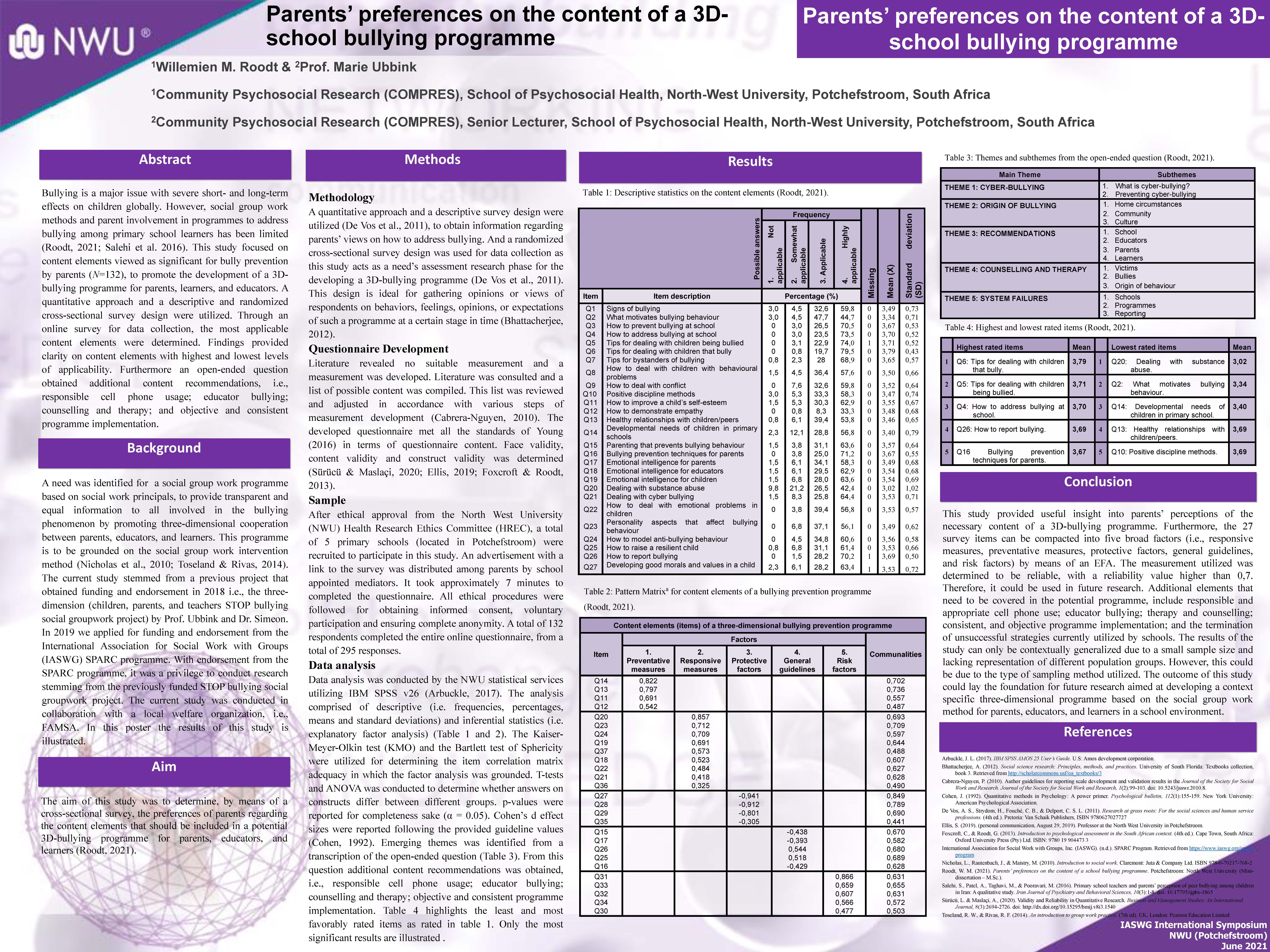Parents' Preferences on the Content of a School Social Group Work Bullying Programme
Willemien Roodt, North West University, Potchefstroom, Swartruggens (South Africa)
Marie Ubbink, North West University, Potchefstroom (South Africa)
A quantitative cross-sectional survey obtained the preferences of primary school learners' parents, on the content of a three-dimensional (parent, learners, and educators) school social group work bullying programme. A descriptive analysis, t-tests, ANOVA and Spearman correlations was done. Data analysis revealed content element rated most applicable and least applicable by parents. Emerging themes was identified in the narrative qualitative question responses. A thematic analysis revealed content that could be added to such a programme.
View PDF of Poster
Presentation Description:
Research studies that involve parents for obtaining their insight on content elements of school group work bullying prevention programmes were identified as minimal, therefore this study aimed at addressing that limitation in research (Roodt, 2021; Salehi et al. 2016). This was done by obtaining parents’ preferences on the content elements that are to be included or addressed in a potential 3D-bullying programme (including parents, educators and learners), through a self-developed questionnaire and a cross-sectional survey conducted at five schools. This would shed some light into the specific needs of different South African schools in communities with varying socio-economic circumstances to promote the development of context-specific school bullying prevention programmes. The study aimed to determine by means of a cross-sectional survey the preferences of parents regarding the content elements that should be included in a potential 3D-bullying programme. A quantitative research approach and a quantitative-descriptive design was followed (De Vos et al. 2011). A randomized cross-sectional survey design was utilized as this study that will act as a needs assessment research phase dealing with the development of a programme, based upon the social group work intervention method in social work (Nicholas et al. 2010; Toseland & Rivas, 2014). The motivation for utilizing this design was that it is ideal for collecting facts and opinions regarding actions, attitudes, perceptions, and expectations regarding a 3D-bullying programme from respondents (parents) at a certain time (Bhattacherjee, 2012). This data where analyzed utilizing IBM SPSS v26 (Arbuckle, 2017), comprising of a descriptive analysis to describe the characteristics of the sample by calculating frequencies and percentages, means and standard deviations. Secondly, an inferential analysis was conducted of the questionnaire in the form of an explanatory factor analysis (EFA) to determine the latent constructs underlying questions of the questionnaire. The Kaiser-Meyer-Olkin test (KMO) and the Bartlett test of Sphericity were used to determine the adequacy of the item correlation matrix, upon which the factor analysis was based. A reliability analysis was conducted by means of Cronbach’s Alpha, to determine the construct’s internal consistence. Further analysis was carried out by means of t-tests and ANOVA, for determining whether the answers on the constructs differed between different groups (i.e. age, home language, etc.). Additionally, p-values are reported for the sake of completeness, with the significance level set at α = 0.05. Furthermore, Cohen’s effect sizes were reported following the guidelines of; 0.2 smaller effect, 0.5 medium effect, and 0.8 large effect (Cohen, 1992). Lastly, the survey was analyzed by means of the seven steps indicated by Creswell and Plano Clark (2013:213-214), including 1) data reduction, 2) data display, 3) data transformation, 4) data correlation, 5) data consolidation, 6) data comparison and 7) data integration. Data collected by an open-ended question at the end of the survey was transcribed to identify corresponding themes that emerged. The key findings of this study could be useful for developing a three-dimensional social group work school bullying programme that include parents, educators, and children to address bullying in primary schools.
- Arbuckle, J. L. (2017). IBM SPSS AMOS 25 User’s Guide. U.S: Amos development corporation.
- Bhattacherjee, A. (2012). Social science research: Principles, methods, and practices. University of South Florida: Textbooks collection, book 3. Retrieved from http://scholarcommons.usf/oa_textbooks/3
- Cohen, J. (1992). Quantitative methods in Psychology: A power primer. Psychological bulletin, 112(1):155-159. New York University: American Psychological Association.
- Creswell, J. W., & Plano Clark, V. L. (2013). Designing and conducting mixed methods research. (2nd ed.). USA: SAGE Publications.
- De Vos, A. S., Strydom, H., Fouché, C. B., & Delport, C. S. L. (2011). Research at grass roots: For the social sciences and human service professions. (4th ed.). Pretoria: Van Schaik Publishers, ISBN 9780627027727
- Nicholas, L., Rautenbach, J., & Maistry, M. (2010). Introduction to social work. Claremont: Juta & Company Ltd. ISBN 978-0-70217-768-2
- Roodt, W.M. (2021). Parents’ preferences on the content of a school bullying programme. Potchefstroom: North West University (Mini-dissertation – M.Sc.).
- Salehi, S., Patel, A., Taghavi, M., & Pooravari, M. (2016). Primary school teachers and parents’ perception of peer bullying among children in Iran: A qualitative study. Iran Journal of Psychiatry and Behavioral Sciences, 10(3):1-8. doi: 10.17795/ijpbs-186
- Toseland, R. W., & Rivas, R. F. (2014). An introduction to group work practice. (7th ed). UK, London: Pearson Education Limited.

